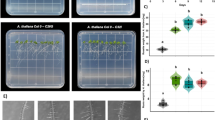Abstract
In laboratory tests the allelopathic potential ofErica vagans, Calluna vulgaris, andDaboecia cantabrica was determined. Aqueous extracts of flowers ofD. cantabrica and leaves ofC. vulgaris inhibit root and hypocotyl growth of red clover, the former causing 51% inhibition of germination. Intact aerial parts of the Ericaceae here studied drastically reduced the growth of red clover and 100% inhibition of germination was caused by flowers ofD. cantabrica. Inhibition of aqueous extracts remains after Chromatographic separation, and two well-defined inhibition zones may be observed. Hydrosoluble organic compounds (phenol-like compounds) could probably be responsible for the inhibitions detected.
Similar content being viewed by others
References
Arines, J. 1973. Estudio de los factures de crecimiento e inhibidores deErica vagans L. PhD dissertation. University of Santiago de Compostela, Spain.
Ballester, A., Arines, J., andVieitez, E. 1972. Compuestosfenolicós en suelos de brezal.Anal. Edaf. Agrobiol. 31:359–366.
Ballester, A., Albo, J.M., andVieitez, E. 1977. The allelopathic potential ofErica scoparia L.Oecologia (Berlin) 30:55–61.
Ballester, A., Vieitez, A.M., andVieitez, E. 1979. The allelopathic potential ofErica australis L. andE. arborea L.Bot. Gaz. (Chicago) 140:433–436.
Carballeira, A. 1980. Phenolic inhibitors inErica australis L. and in associated soil.J. Chem. Ecol. 6:593–596.
Carballeira, A., andCuervo, A. 1980. Seasonal variation in allelopathic potential of soils fromErica australis L. heathland.Oecol. Plant. 1:345–353.
Chou, C.H., andMuller, C.H. 1972. Allelopathic mechanisms ofArctostaphylos glandulosa var.zacaensis. Am. Midi. Nat. 88:324–347.
Mantilla, J.L.G. 1974. Estudio de los factures de crecimiento y germinatión deCalluna vulgaris (L.) Hull. PhD dissertation, University of Santiago de Compostela, Spain.
McPherson, J.K., andMuller, C.H. 1969. Allelopathic effects ofAdenostoma fasciculatum, charaise, in the California chaparral.Ecol. Monogr. 39:177–198.
Rice, E.L. 1974. Allelopathy. Academic Press, New York.
Author information
Authors and Affiliations
Rights and permissions
About this article
Cite this article
Ballester, A., Vieitez, A.M. & Vieitez, E. Allelopathic potential ofErica vagans, calluna vulgaris, andDaboecia cantabrica . J Chem Ecol 8, 851–857 (1982). https://doi.org/10.1007/BF00994785
Received:
Revised:
Issue Date:
DOI: https://doi.org/10.1007/BF00994785




